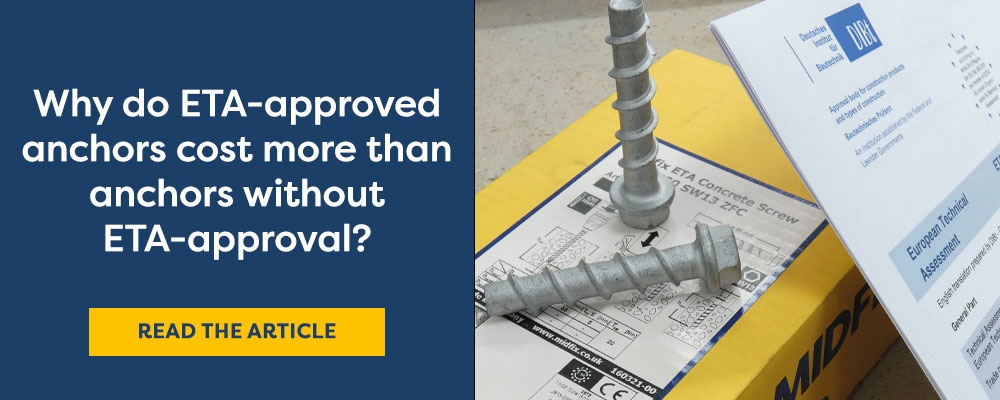As a first fix supplier to the M&E sector our team are often asked:
Why should I specify an ETA-approved anchor?
This is a perfectly reasonable question, after all, you have a budget to stick to and it can be frustrating when you compare the price of one ETA-approved anchor over a non-ETA-approved anchor and notice that there is a cost difference. In order to answer this question, I have put together key information to help you come to a decision.
To support this article I have put together a short video that provides further clarification as to why specifying an ETA-approved anchor is both worthwhile from a price point and more importantly from a safety, compliance angle.
What does ETA stand for?
ETA stands for European technical assessment. The ETA is a set of harmonised standards that tests the performance of an anchor. With an ETA-approved anchor, a specifier can compare the product performance of one anchor to another and will know its true performance.
What type of testing is carried out?
The ETA carries out independent performance tests. They test the anchors in various substrates, various loads, various embedment depths, oversized holes, undersized holes it's quite a rigorous and onerous testing regime.
Other examples of tests carried out by the ETA include:
- Over-torque the anchor
- Fixing it close to the edge
- Testing anchors on various different substrates
- Undersized or oversized holes
- A specific substrate test can be carried out, matching the on-site application
What does the ETA testing tell us?
The ETA carries out independent testing on a particular anchor for a particular substrate. The ETA uses the mean value of a set of test results providing an accurate ETA loading specification.
Every ETA approved anchor comes with a report which contains;
- Manufacturers details including plant/part number
- Product name and intended use
- Details of the assessment programme
- Installation instructions
- ETA assessment number
- The performance of the anchor within a specific application
- The control task of the manufacturer, depending on the relevant AVCP systems
What are the overall benefits of specifying an ETA-approved anchor?
- Comply with the recommendations of BS 8539 safeguarding the liabilities of the parties involved
- Performance values provided by the manufacturer can be consistently relied upon
- All parties to the construction process can be confident in the long-term security of the fixings
- Site testing is not required for an ETA anchor where the manufacturer provides data for the substrate in question and the installation is undertaken by competent operatives under supervision
Why are ETA's beneficial to the manufacturer?
From a manufacturer's point of view if an anchor goes through rigorous testing and the performance data is independent - it is reliable.
Why are ETA's beneficial to the contractor?
For contractors, an ETA provides trust and assurance that the anchors specified on-site work to a specific performance standard. It is advised that all anchors used for suspending services from concrete ceilings need to have an ETA that covers cracked concrete.
Why are ETA's important for an installer/designer?
For a designer or an installer an ETA verification can help them specify and install the right anchor as there is clear data to refer to. If the installation conditions are as per the ETA test, then that is a guarantee that the fixing will achieve that load value.
Can I trust an anchor that does not have an ETA approval?
Unfortunately, there is no definitive answer to this, because you are relying upon the manufacturer's in-house performance tests and not an independent third party.
Without an ETA anchor, it is unclear whether or not it will withstand the load, we have seen in the past what can happen when an anchor installation failure occurs.
The CFA (Construction Fixings Association) highlights two case studies showing the damaging effects of anchor installation failure -



.png?width=1000&name=MicrosoftTeams-image%20(347).png)
